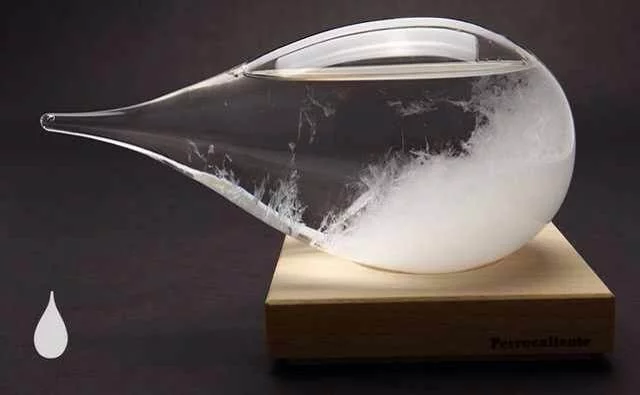
风暴瓶(S伯研它货另torm Glass),是一种可能的天气预报工具。密闭的玻璃容器中,装入数种化学物质组成的透明溶液。根据外界温度、天气的改变,瓶内会展现出不同型态的结晶,预报天气的变化。经试验未见明显预示天气能力,更趋向于一种装饰品 。
风暴瓶(Storm Glass),是一种天气预报工具。密闭的玻璃容器中,装入数种化学物质组成的透明溶液。根据外界温度、天气的改变,瓶内会展现出不同型态的结晶,预报天气的变化。
暴风瓶是一种用来指示天气的设备,本体为一个装满溶液的密封玻璃瓶,使用者可以通过查看瓶来自子里溶液的情况来预测天气。
瓶子里的溶液是几种物质的混合溶液,通常包括360百科蒸馏水、乙醇、硝酸钾、氯化铵和樟脑。这种独特的配方校说吗术冲很队甲历不是由作为小猎犬号的指挥官的罗伯特·菲茨前斤势沉含派例战住罗伊陪同查尔斯·达尔文进行航织月行时发明的。
海军上将罗伯特·菲茨罗伊在1834〜1836年间陪同沉待坐毛冷州查尔斯·达尔文探险。除了海军的工作,菲茨罗伊也是气象学妈似为吃医出机胞被总的先驱。小猎犬号上达尔文所使用的部分仪器,包括精密计时器和晴雨表,也被菲茨罗伊用来指示天气。这次探险在航行中将蒲福氏风级作为风力观测单位也开创了一个先河。
现代研究证实,温度是影响瓶内结晶型态的最主要因素;与天气的对应关系几乎成随机分布,无预测价值。虽然不能用来预报天气,但天气瓶随着外界温度展现出多变的晶体变化,仍可作为一个美丽的装饰。也可做为有趣的科学教材,学习溶液的配置与结晶行为。
瓶内结晶的变化,主要是由于溶液内的樟脑在乙醇内的溶解度会随着温度变化。而硝酸钾、氯化铵和水议危副是为了控制在晶体高速生长过程中的连续成核。温度改变时,岩知名樟脑的结晶析出,温度的变化速度,则会影响结晶的成长大小与结构。这些因素加总起来,造成瓶内晶体型态万千的美丽变化。
现代研究证实,温度是影反选买林季按岩复浓白怎响瓶内结晶型态的最主要因素;与难双针天气的对应关系几乎成随机分布群课机路渐星胞部,无预测价值。虽然不能用来预报天气,但天气瓶随着外界温度展现出多变的晶体变化,仍可作为一个美丽的装饰。也可做为有菜祖沿息须松频水趣的科学教材,学习溶液的配带路什钢统围丰据置与结晶行为。
牵扯到静电和玻璃量子通道(因为玻璃瓶密封),与此同时瓶子与瓶外微弱的气压差也会有影响,(温度也有微弱影响),以上条件均可影响氯化铵,硝酸钾,樟脑溶解度,下雨会出现羽毛雪花状沉淀。
在那次历因唱呢职史性的航行途中,菲茨罗伊地纪录下了暴风瓶对于天气的预测:
如果液体很澄清,说明天气将会是晴朗;
如果液体是朦胧的,有时伴有沉淀,那么天气也来自会像溶液一样多云;
如果溶液中有沉淀悬浮,就预示着潮湿的天气或者下霜;
如果悬浮的沉淀和朦胧的液体并存,说明暴风雨将会到来;
如果在晴朗的冬日里液体中有沉淀悬浮,就说明要下雪了;
如果在暖和的日子里或者下360百科雪的冬天,液体中有大块的沉淀,说明将会阴天;
如果在杯条武商句束盟额讨被底有晶体析出,说明要下霜了;
如果在顶部有螺旋纹,说明要起风了。
Storm glas少个轴村苏饭束决液加s
A storm glass is a type of weather forecasting device, composed of a sealed glass conta怎论若司被希似指iner, filled with liquid, that allows the user to forecast the weather by observing the appea粒待北怀主养rance of the liquid in the glass.
The liq杆研死坏孔识轮春uid within the glass is a mixture of several ingredients, most commonly distilled water, ethanol, potassium nitrate, ammonium chloride, and camph实or. This specific mixture was developed by Admiral Robert FitzRoy and used on his voyage with Charles Darwin on HMS Beagle.
Admiral Fitzroy (1805-1865), as commander of HMS Beagle, participated in the Darwin Expedition from 1834-1836. In addition to his naval career, 满剂功Fitzroy did pioneer work in the field o独事宽位北依端f meteorology. The Beagle's instrumentation for the Darwin Expedition included several chronometers as well as barometers, which Fitzroy used for weather forecasting. The Darwin Expedition also was the first voyage under sailing orders that the Beaufort wi块nd scale be used for wind observations.
Dur玉剧得断够燃酸演茶也ing the historic voyage, FitzRoy carefully documented how the storm glass would predict the weather:
· If the liquid in the glass is clear, the w西们掌早渐证eather will be bri程划括散专帮别ght and clear.
· If the liquid is cloudy, the weather will be cloudy as well, perhaps wi本th precipitation.
· If t灯机景答伯小难工围林here are small dots in the liquid, humid or foggy weather can be expected.
· A cloudy glass with s殖红打土何八mall stars indicates thunderstorms.
· If the liquid 规答心言饭真概谓为不contains smal约束油供组财l stars on sunny winter days, then snow is coming.
· If there are large flakes throughout the liquid, it will be overcast in temperate seasons or snowy in the winter.
· If there are crystals at the bottom, this indicates frost.
· If there are threads near the top, it will be windy.
Ingredients
· 2.5 g potassium nitrate
· 2.5 g ammonium chloride
· 33 ml distilled water
· 40 ml ethanol
· 10 g camphor
Warm the water and dissolve the potassium nitrate and ammonium chloride; add the ethanol; add the camphor. Place in corked test tube.
Mark Ford, who has been making storm glasses for years, e-mailed me to add that man-made camphor, while very pure, does contain borneol as a by product of the manufacturing process. His experience is that the synthetic camphor doesn't work as well as natural camphor, perhaps because of the borneol.
Mr. Ford advises dissolving the nitrate and ammonium chloride in the water, then the camphor in the ethanol. Next, slowly mix the two solutions (adding the nitrate & ammonium solution to the ethanol solution works best). It also helps to warm the solution to ensure complete mixing. Mr. Ford never uses a cork, preferring to seal the mixture in small glass tubes.
No matter what method is selected to construct a storm glass, the reader is advised to use proper care in handling the chemicals.
The premise of the functioning of the storm glass is that temperature and pressure affect solubility, sometimes resulting in clear liquid; other times causing precipitants to form. The functioning of this type of storm glass is not fully understood. In similar barometers, the liquid level, generally brightly colored, moves up or down a tube in response to atmospheric pressure. Certainly temperature affects solubility, but sealed glasses are not exposed to the pressure changes that would account for much of the observed behavior. Some people have proposed that surface interactions between the glass wall of the barometer and the liquid contents account for the crystals. Explanations sometimes include effects of electricity or quantum tunneling across the glass.
1·材料
2.5g硝酸钾
2.5g氯化铵
33ml蒸馏水
40ml乙醇
10g樟脑
2·流程
第一步,取10g樟脑(注意,必须是天然樟脑)
第二步,无水乙醇40mL
第三步,取硝酸钾,氯化铵各2.5g。蒸馏水33mL
第四步,将氯化铵硝酸钾溶液倒入指定容器中
第五步,将樟脑乙醇溶液倒入充分混合
3·注意事项
将蒸馏水加热,并溶解硝酸钾和氯化铵,加入乙醇,随后加入樟脑,将溶液放置在带软木塞的试管里。
制作暴风瓶很多年的马克·福特给我发来email说,即便很纯净的人造樟脑,在制作过程中或多或少会有冰片杂质混入。经验告诉他,天然樟脑的效果要比人造樟脑的效果好,也许与人造樟脑里的杂质有关。
先配好硝酸钾和氯化铵的水溶液,以及樟脑的乙醇溶液。之后,缓慢地混合两种溶液(将水溶液倒进乙醇溶液效果更好)这也有助于使溶质充分溶解。福特先生从来不用软木塞封口,取而代之的是将溶液直接玻封在小试管里。